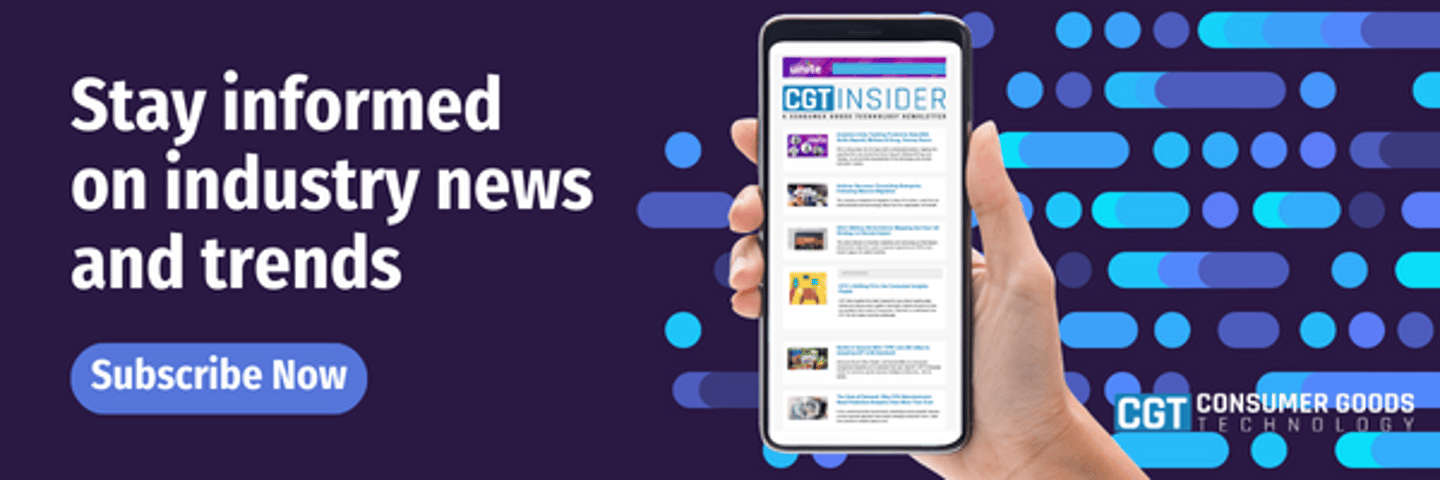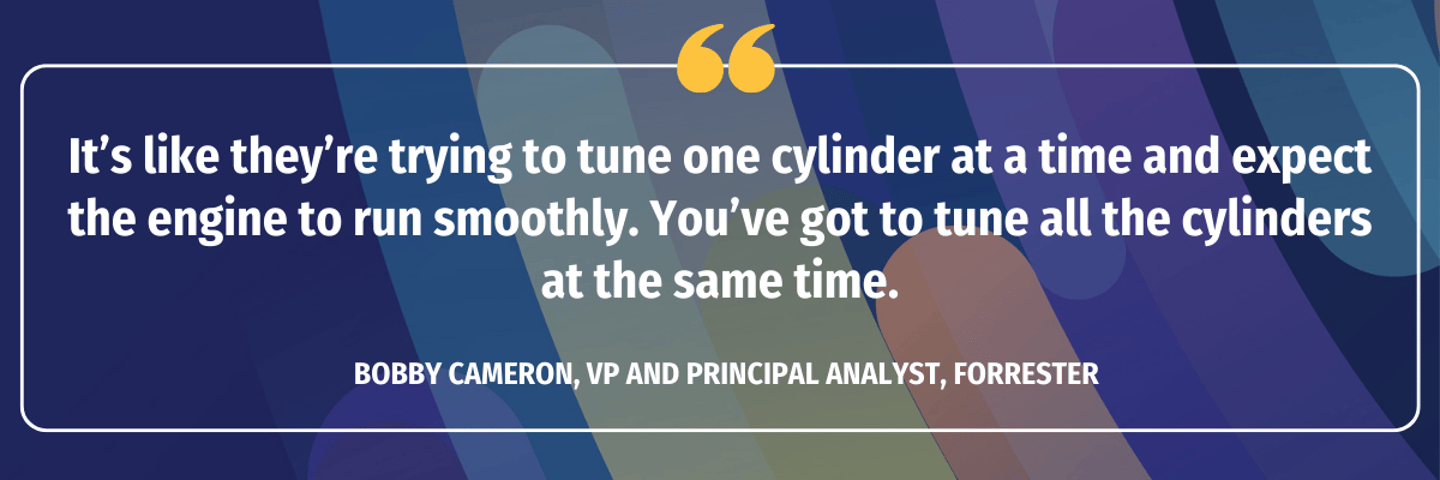7 Proven Ways CPG Companies Can Elevate IT High-Performers
Articles advocating methods to motivate and retain employees are a dime a dozen. But motivating and retaining the new breed of IT high performer carries a heightened level of urgency in order to keep them happy and engaged.
Here are some specific ways consumer goods companies can motivate and retain their tech high performers in this challenging IT employment environment.
1. Create a Whole-Company IT Strategy
Forrester defines 58% of companies as “traditional,” companies that view IT as mere order takers, as a cost center, as a necessary evil, and therefore approach IT piecemeal as needed. “It’s like they’re trying to tune one cylinder at a time and expect the engine to run smoothly,” Bobby Cameron, VP and principal analyst at Forrester, tells CGT. “You’ve got to tune all the cylinders at the same time.”
More forward facing is the 37% of companies Forrester finds are “modern,” that have made IT a partner with the business. In “modern” companies, IT doesn’t “work in silos, they work across the enterprise as well as across their various go to market partners, their business and technology ecosystems, as well as the end customer,” Cameron explains. And the 6% of companies that Forrester identifies as “future fit” use IT to “recreate core business capabilities dynamically and rapidly,” and proactively deploy predictive analytics.
“Modern” and especially future-fit CPGs attract, motivate, and retain the cream of the IT crop, he notes. With digitalization, CPGs have recognized they’ve all essentially become software companies and, with the rise of remote work, supporting hundreds if not thousands of satellite offices. “We’ve never seen such a heightened focus on the importance of IT,” says Daniel Turchin, CEO of PeopleReign, an AI-powered HR platform.
2. Give IT a Seat at the Table
CPG companies that recognize the integral role IT plays in every aspect of their businesses have awarded C-suite seats to their CIOs. But CIOs now must engage the company’s far-flung IT talent in strategy, direction, and tactics decisions.
“While some IT talent is most motivated by technical challenges, some want to see how their technical contributions impact the broader organization,” says M. Eric Johnson, the Bruce D. Henderson Professor of Strategy at Vanderbilt’s Owen School of Management. “Bringing them into a discussion on IT strategy alignment can be a game changer, both for the individual and for the company.”
For CPG companies, stretching the normal hierarchical corporate structure isn’t a muscle often exercised. “Traditionally, CPG companies lack proper top-down communication of general business knowledge on what the company does, the vision and goals as it continues to grow and evolve,” says Sourav Banerjee, Infosys consumer retail and logistics SVP and industry head. “Through prioritizing employee understanding and granting employee input into strategy, policies, standards, and oversight, their talent will become engrained in the growth of the organization.”
Turchin suggests creating forums where IT staff can use collaborative tools such as Slack, Teams, or internal channels to share their feedback, to “feel like they have a direct line of communication to their leader, the CIO, and then, by extension, the board.”
3. Allow IT People to be Creative
Many CPGs fail to unlock the potential of their IT staff by too often burdening them with non-value administrative tasks, according to Charles Chase, SAS executive industry consultant. Chase champions enabling IT workers to focus on more innovative activities that drive revenue and profitability, and to give employees more time to think, collaborate, and learn with their co-workers. ”As a result, they see the bigger picture and stay motivated.”
Not stifling IT staff with “Office Space”-like digital paper pushing is just half the battle to maintain motivation and engagement. Johnson suggests providing time, budget, and accountability to allow IT to experiment with the latest technologies such as AI, machine learning, the metaverse, AR and VR, which also illustrates how their company can be a crusader of new technology.
To exhibit the value of IT creativity, “consciously document how the latest technology saves your team time and money that can be redirected toward renewed creativity that leads to innovation,” Chase advises. “Make sure the C-suite understands your team, and its high performers take the organization’s time and resources seriously and uses technology to stretch both.”
4. Inculcate IT into the Whole Business
Creativity in a vacuum can be more harmful than helpful, which increases the importance of IT people understanding not only the overarching goals of a company’s business, but its operational inner workings and subtleties. Forrester’s Cameron noted that a number of retailers bring IT staff to work at brick-and-mortar stores during the holiday shopping season to see how what they build back in their hermetically sealed offices works on the front lines.
“Putting high-flying IT talent into the field where they can see the challenges firsthand helps IT stay aligned with the business,” Vanderbilt’s Johnson says. “For CPG firms, everyone benefits with service groups like IT seeing consumers using the product and interacting with the company, [such as] through customer support.”
5. Let IT be Part of Third-Party Platform Choice
Many CPGs now deploy third-party platforms to run specific operations — but these third-party platforms still need to be integrated into a company’s existing IT infrastructure, or even require changes to existing infrastructure. In either event, directly impacted IT staff should be made part of the platform selection process to begin with, not just perfunctorily to make them feel as if they’re part of the process but to ease platform integration and speed adoption and effectiveness. “It is a value development tool,” Chase notes, “and ultimately a useful way to ensure IT organization buy-in to big decisions.”
According to Cameron, without first involving IT, many CPGs merely buy and then try to modify third-party platforms without understanding them. Having IT involved from the start helps eliminate this often ineffective after-the-fact tinkering. After “they can’t figure out why they don’t get the power out,” Cameron notes, the company decides “it must be something wrong with the tool! Third-party tools are more pedantic and have to be fitted to whatever specific business that is going to use them. There’s a degree of IT creativity that needs to be brought into it.”
6. Allow IT to be Socially Responsible
IT workers also are members of society impacted by the potential intrusion of big data in their lives, and can be demotivated if not consulted when asked to build potentially intrusive big data tools for their companies.
“We are seeing shifts in the CPG sector and society happening simultaneously,” Infosys’ Banerjee says. “On the one hand, CPG companies are shifting priorities to the growth of ethical and conscious consumers, autonomous and resilient supply chains, and personalized retail, among others. On the other, today’s workers are invested in organizations that make concerted efforts to tackle societal issues, reaching beyond revenue and productivity.”
Keeping IT in tune with integrated socially conscious solutions also helps build trust up, down, and through the supply chain, which keeps IT staffers feeling positive about their company. “In the ‘modern’ world, what happens is the security people are there day-to-day with the same people who are building the new product and the support services,” Cameron adds. “They’re all working together.”
7. Train, Train, and Re-Train
Technology is changing far faster than ever, which means “the needs of technical talent are constantly changing,” Banerjee says. “It’s invaluable for the technical employees — and the company — to keep their skills sharp and help them stay on the cutting edge of technology innovation.” Nearly all executives CGT spoke to urged companies to consider partnering with local universities for continuing training for their IT workers as well as tuition reimbursement programs.
Technology also evolves over time, requiring both short- and longer-term planning to keep IT staff effectively looking ahead and prepared for inevitable business changes and surprises. “Look forward to get the best talent preparing for roles — sometimes even years before they might be ‘ready,’” Johnson advises. “Investing in training and development is one of the [top] job retention tools for young talent, showing commitment to the individual and opening up new career paths.”
Like sporting teams, the best motivated IT workers will be overall “good athletes” who can and are motivated to be “cross-trained on the different tasks so that they’re not siloed,” Turchin notes.
“High performers often aren’t content with staying in their lane and want new challenges and opportunities to grow,” echoes Charman Hayes, technology EVP for people and capability at Mastercard. “Connecting them with other opportunities within other teams is a great way for them to pick up new skills and network while also helping those teams complete their projects with a valuable resource they don’t usually work with.”








